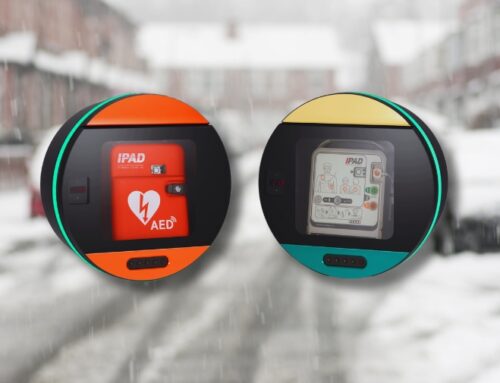In the critical moments following a cardiac emergency, every second counts. It’s in these seconds that the integration of Cardiopulmonary Resuscitation (CPR) and Automated External Defibrillators (AEDs) can mean the difference between life and death. This powerful combination is not merely a suggestion—it’s an essential strategy for maximising survival rates in situations where time is of the essence.
The integration of CPR and AED techniques provides an unparalleled advantage by addressing both the immediate need for circulation and the underlying electrical malfunction of the heart. This one-two-punch approach has proven to be a game-changer in emergency cardiac care. As we delve deeper into the topic, we will explore the individual roles of CPR and AED. From current guidelines to scientific evidence behind their combined use and the latest technological advancements, we’ll investigate what contributes to this life-saving duo’s effectiveness.
Understanding the Role of CPR and AEDs in Cardiac Emergencies
CPR and AEDs both play pivotal roles in the management of cardiac emergencies. Their individual contributions are vital, but it’s the crucial combination of CPR and AED use that maximises chances of survival.
CPR is a manually performed technique involving chest compressions and rescue breaths, designed to temporarily maintain a flow of oxygenated blood to the brain and heart during a cardiac arrest. It serves as an interim measure, keeping the victim alive until more definitive treatment can be provided.
Meanwhile, an AED is a portable device used to diagnose and treat life-threatening cardiac arrhythmias through defibrillation, which is the application of electrical therapy to re-establish a productive heart rhythm.
Both interventions have their place in the chain of survival. However, they are most effective when used in tandem. CPR alone can only buy time by providing minimal blood flow to the heart and brain. It cannot correct an abnormal heart rhythm. Conversely, while an AED can potentially reset the heart’s rhythm, it cannot circulate oxygenated blood to the body’s vital organs.
The Science Behind CPR and AED Integration
The integration of CPR and AED use is not an arbitrary combination but a strategy grounded in scientific evidence. Both interventions play complementary roles in managing cardiac emergencies, addressing different aspects of the problem, and thus, when used together, significantly increase survival rates.
Cardiac arrest typically occurs due to a malfunction in the heart’s electrical system, resulting in abnormal rhythms called ventricular fibrillation (VF) or ventricular tachycardia (VT). These conditions cause the heart to oscillate without adequately pumping blood. CPR serves as a stopgap measure during these events, manually mimicking the heart’s pumping action to maintain minimal blood flow to the brain and other vital organs.
However, CPR cannot correct VF or VT. This is where an AED comes in. An AED diagnoses the heart’s rhythm and delivers a shock if needed to reset the heart’s electrical activity and restore a normal rhythm.
The critical factor here is time. The sooner an AED is used after the onset of VF or VT, the higher the chances of survival. But locating, activating and deploying an AED takes time. This is the period in which to deliver consistent and careful CPR as close to expert guidelines as possible.
Current Guidelines and Best Practices for CPR and AED Use
The integration of CPR and AED use is a potent combination that can significantly increase survival rates in cardiac emergencies. However, to maximise the benefits, it’s essential to follow the current guidelines and best practices. Often, these are developed by leading organisations such as the American Heart Association (AHA) and the European Resuscitation Council (ERC).
According to the ERC, CPR involves immediate initiation of chest compressions at a rate of 100-120 per minute, with a depth of at least two inches in adults. Rescue breaths should be given every 30 compressions. For untrained bystanders, hands-only CPR is recommended as it’s easier to perform and can be equally effective.
When using an AED, it should be implemented as soon as it becomes available. The device should be turned on, and the pads should be attached to the victim’s chest as instructed. The AED will then analyse the victim’s heart rhythm and advise if a shock is needed. Consistency in chest compressions and early defibrillation with an AED have been identified as critical factors in improving survival rates.
Above: WEL Medical’s iPAD range
Technological Advancements in CPR and AEDs
Life-saving interventions like CPR equipment and up-to-date AEDs have been significantly enhanced by technological advancements. WEL Medical, a leading player in the field, offers state-of-the-art products that exemplify these innovations.
WEL Medical’s iPAD SP1 AED is a prime example of how technology is improving cardiac emergency response. Offering superior features and enhanced performance, the success of the iPAD SP1 speaks for itself. With a reputation for reliable supply, support and quality, it’s currently being placed in conjunction with every UK NHS ambulance service for use in community public access schemes.
Alongside AEDs, advancements in CPR equipment, such as the extensive range of Brayden CPR Manikins that we offer, are making training more effective. This innovative manikin provides real-time visual feedback on the quality of chest compressions and ventilations, enhancing the learning experience and ensuring that trainees are well-prepared for real-life emergencies.
Above: Brayden CPR Manikin with LED lights
Empower Your Emergency Response with WEL Medical
Explore WEL Medical’s range of advanced CPR manikins and AEDs, designed with the latest technology to facilitate the integration of CPR and AED.
Our products not only meet but exceed expectations, offering superior features and enhanced performance ability. Don’t compromise on quality when lives are at stake – choose WEL Medical for all your emergency healthcare equipment needs.








